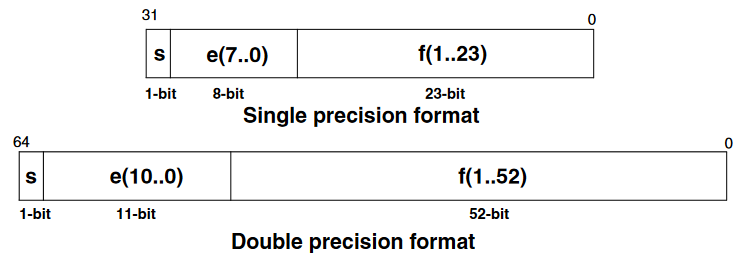Floating-Point Unit (FPU)
Intro
Why Floating-Point?
STM AN4044| Coding | Dynamic [dB] |
|---|---|
| Int32 | 192 |
| Int64 | 385 |
| Single precision | 1529 |
| Double precision | 12318 |
Floating-Point Unit
The STM32 ARM Cortex M4F MPUs (e.g. STM32WB, STM32F4, STM32L4) have a single precision floating-point unit. The STM32H7 MPUs have a double precision FPU (not supported yet). Also from STM AN4044- Align the two numbers (have them with the same exponent)
- Perform the operation
- Round out the result
- Code the result
Normalized Numbers Range
| Mode | Exponent | Exp. Bias | Exp. Range | Mantissa | Decimal digits | Min. value | Max. Value |
|---|---|---|---|---|---|---|---|
| Single | 8-bit | 127 | -126,+127 | 23-bit | 7.22 | 1.18E-38 | 3.40E38 |
| Double | 11-bit | 1023 | -1022,+1023 | 52-bit | 15.95 | 2.23E-308 | 1.8E308 |
IEEE.754 Single and Double Precision Floating-Point Coding

FPU's Dark Corners
Some Links
- https://forth-standard.org/standard/float

- https://en.wikipedia.org/wiki/IEEE_754

- https://en.wikipedia.org/wiki/Single-precision_floating-point_format

- Fixed Point

- https://www.complang.tuwien.ac.at/forth/gforth/Docs-html/Number-Conversion.html#Number-Conversion

- https://www.complang.tuwien.ac.at/forth/gforth/Docs-html/Floating-Point.html#Floating-Point

- https://forth-standard.org/proposals/recognizer#contribution-142

- https://interrupt.memfault.com/blog/cortex-m-rtos-context-switching
 ARM Cortex-M RTOS Context Switching
ARM Cortex-M RTOS Context Switching
- https://mcuoneclipse.com/2019/03/29/be-aware-floating-point-operations-on-arm-cortex-m4f/

- http://support.raisonance.com/content/how-should-i-use-floating-point-unit-fpu-cortex-m4

Floating-Point Words
No separate floating-point stack. A single precision floating-point number is one cell. The 32-bit base-2 format is officially referred to as binary32 IEEE 754-2008Bare FPU Words (Without C Math Library)
f+ ( r1 r2 -- r3 ) Add r1 to r2 giving the sum r3
f- ( r1 r2 -- r3 ) Subtract r2 from r1, giving r3
f* ( r1 r2 -- r3 ) Multiply r1 by r2 giving r3
f/ ( r1 r2 -- r3 ) Divide r1 by r2, giving the quotient r3
fsqrt ( r1 -- r2 ) r2 is the square root of r1
fabs ( r1 -- r2 ) r2 is the absolute value of r1
fnegate ( r1 -- r2 ) r2 is the negation of r1
fround ( r1 -- r2 ) round r1 to an integral value using the "round to nearest" rule, giving r2
fflags@ ( -- u ) get the current value of the Floating Point Status/Control register FPSCR
fflags! ( u -- ) assign the given value to the Floating Point Status/Control register FPSCR
f0= ( r -- ? ) flag is true if r is equal to zero
f0< ( r -- ? ) flag is true if r is less than zero
f< ( r1 r2 -- ? ) flag is true if r1 is less than r2
f~ ( r1 r2 r3 -- ? ) If r3 is positive, flag is true if the absolute value of (r1 minus r2) is less than r3
If r3 is zero, flag is true if the implementation-dependent encoding of r1 and r2 are exactly identical
(positive and negative zero are unequal if they have distinct encodings).
If r3 is negative, flag is true if the absolute value of (r1 minus r2) is less than the absolute value
of r3 times the sum of the absolute values of r1 and r2.
f>s ( r -- n ) n is the single-cell signed-integer equivalent of the integer portion of r
s>f ( n -- r ) r is the floating-point equivalent of the single-cell value n
f>fx ( r -- x ) x is the fixed-point equivalent of the floating-point r
fx>f ( x -- r ) r is the floating-point equivalent of the fixed-point x
pi ( -- r ) r is pi, approx. 3.14159274101257324
e ( -- r ) r is e, approx. 2.7182818
fnumber (a # -- r u ) convert the specified string by a and # to float r, on success u is 1, otherwise 0
>float (a # -- r ? ) convert the specified string by a and # to float r, on success flag is true (more robust)
f. ( r -- ) display, with a trailing space, the floating-point number r in fixed-point notation
fe. ( r -- ) display, with a trailing space, the floating-point number r in engineering notation
fs. ( r -- ) display, with a trailing space, the floating-point number r in scientific notation
precision ( -- u ) return the number of significant digits currently used by F., FE., or FS. as u
set-precision ( u -- ) set the number of significant digits currently used by F., FE., or FS. to u
Words Using C Math Library
fsin ( r1 -- r2 ) r2 is the sine of the radian angle r1
Fixed-Point Words
Fixed-pointd+ ( x1 x2 -- x3 ) add x1 to x2 giving the sum x3 d- ( x1 x2 -- x3 ) subtract x2 from x1, giving x3 x* ( x1 x2 -- x3 ) multiply x1 by x2 giving x3 x/ ( x1 x2 -- x3 ) divide x1 by x2, giving the quotient x3 x. ( x -- ) display, with a trailing space, the fixed-point number x x.n ( x n -- ) print a fixed-point number x with n fractional digits (truncated) x#S ( n1 -- n2 ) Adds 32 comma-digits to number output x# ( n1 -- n2 ) Adds one comma-digit to number output sqrt ( x1 -- x2 ) x2 is the square root of x1 sin cos tan asin acos atan log2 log10 ln pow2 pow10 exp floor deg2rad ( deg -- rad ) rad2deg ( rad -- deg ) pi pi/2 pi/4 +inf -inf fixpt-mat-lib.fs

This work by Peter Schmid is licensed under a Creative Commons Attribution-ShareAlike 4.0 International License.
| I | Attachment | History | Action | Size | Date | Who | Comment |
|---|---|---|---|---|---|---|---|
| |
Float_example-header.png | r1 | manage | 28.2 K | 2022-11-05 - 10:45 | PeterSchmid | |
| |
ieee-754.png | r1 | manage | 12.7 K | 2022-11-02 - 11:52 | PeterSchmid |
Topic revision: r21 - 2022-11-05 - PeterSchmid
Ideas, requests, problems regarding TWiki? Send feedback



